A thigh massage is focused on the hamstring and quadriceps muscles located at the front and back of the upper half of the leg. A thigh massage involves a range of different techniques that help reduce muscle tightness, relieve pain and increase blood circulation. A thigh massage can relieve tension and stress within the muscles and can help a person being treated return to sports or exercise. Massage therapists at Physio.co.uk use thigh massage to treat muscle tightness and relieve any pain, stress and tension.
What techniques are used in a thigh massage?
There are various techniques included during a thigh massage. Common techniques used during a thigh massage include:
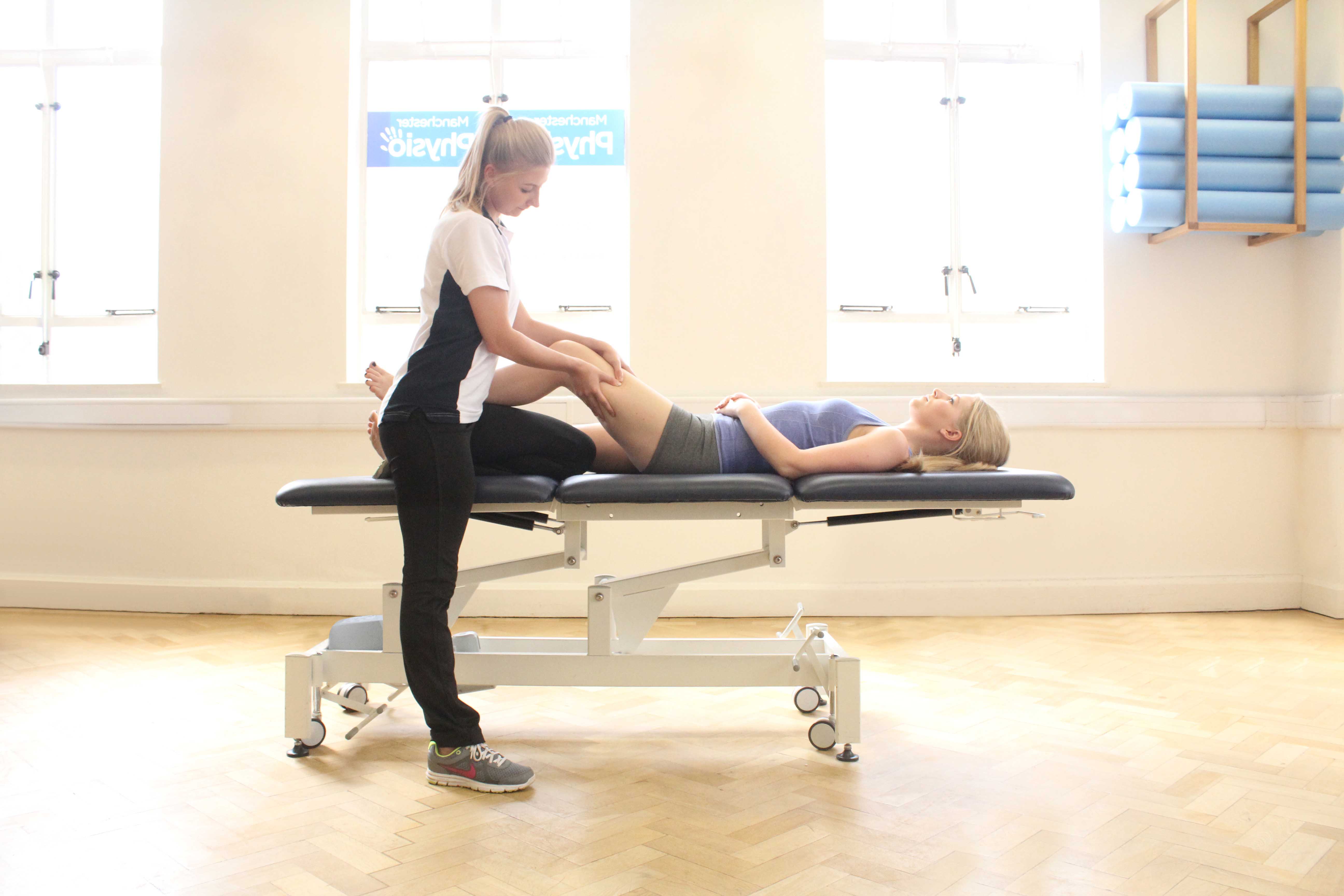 Above: Deep tissue massage of rectus femoris and vastus lateralis
Above: Deep tissue massage of rectus femoris and vastus lateralisEffleurage is an effective technique used during a thigh massage. Effleurage is performed using flat hands and fingers. Ranging from firm to light pressure, effleurage is used to increase the temperature of the muscles and encourage an increase of blood flow around the muscles. An increase in temperature to the muscles improves tissue elasticity and flexibility around a joint. Improving tissue elasticity reduces tension and tightness within muscles and therefore reduces pain. Effleurage also improves the lymphatic circulation, helping with the removal of waste products and toxins that are found in the muscles.
Kneading is a common technique used during a thigh massage. Kneading is used on the thigh in the areas containing soft tissues. Kneading is where the muscles are squeezed and pulled slowly. Kneading helps improve the blood circulation as the muscles increase in temperature. When temperature is increased, vasodilation and capillarisation occurs. Vasodilation is where the blood vessels become wider so that blood flow can be increased. Capillarisation is where there is an increase in capillaries that provide the muscles with a larger amount of oxygen. Kneading also helps with the removal of waste products and toxins by stimulating the lymphatic circulation. Improving both the blood and lymphatic circulation helps maintain healthy muscles.
Frictions are effectively used during a thigh massage. Frictions are performed using the fingertips and thumbs. Frictions are used in areas where muscular knots are found along muscles fibres. Frictions are used to increase the temperature of the muscles and break down collagen fibres. Increasing the temperature of the muscles results in the reduction of tightness, pain and muscle spasms. Collagen fibres are laid across the muscle tissue as part of the healing process and can become restrictive. Breaking down collagen fibres, reduces muscle restriction therefore decreasing pain.
Wringing is used during a thigh massage. Wringing is performed using flat hands and fingers. Wringing is where tissues in the muscles are picked up from both sides of the thigh and are pulled in towards the middle in opposite directions. Pressure varies from light to firm from the starting point to the middle of the thigh where the muscle tissues are pulled into. Wringing helps loosen and stretch muscles, relieving the thigh of any muscle tightness. Wringing can be a relaxing experience but is also a very effective technique to help ease pain.
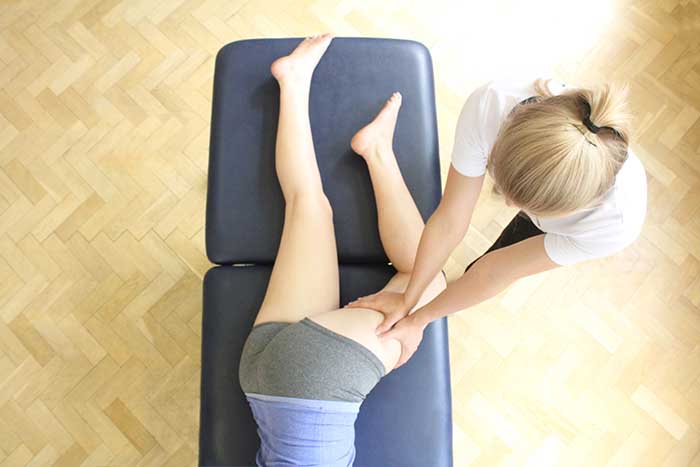
When can a thigh massage help?
There are many situations where a thigh massage can help. Situations where a thigh massage can help include:
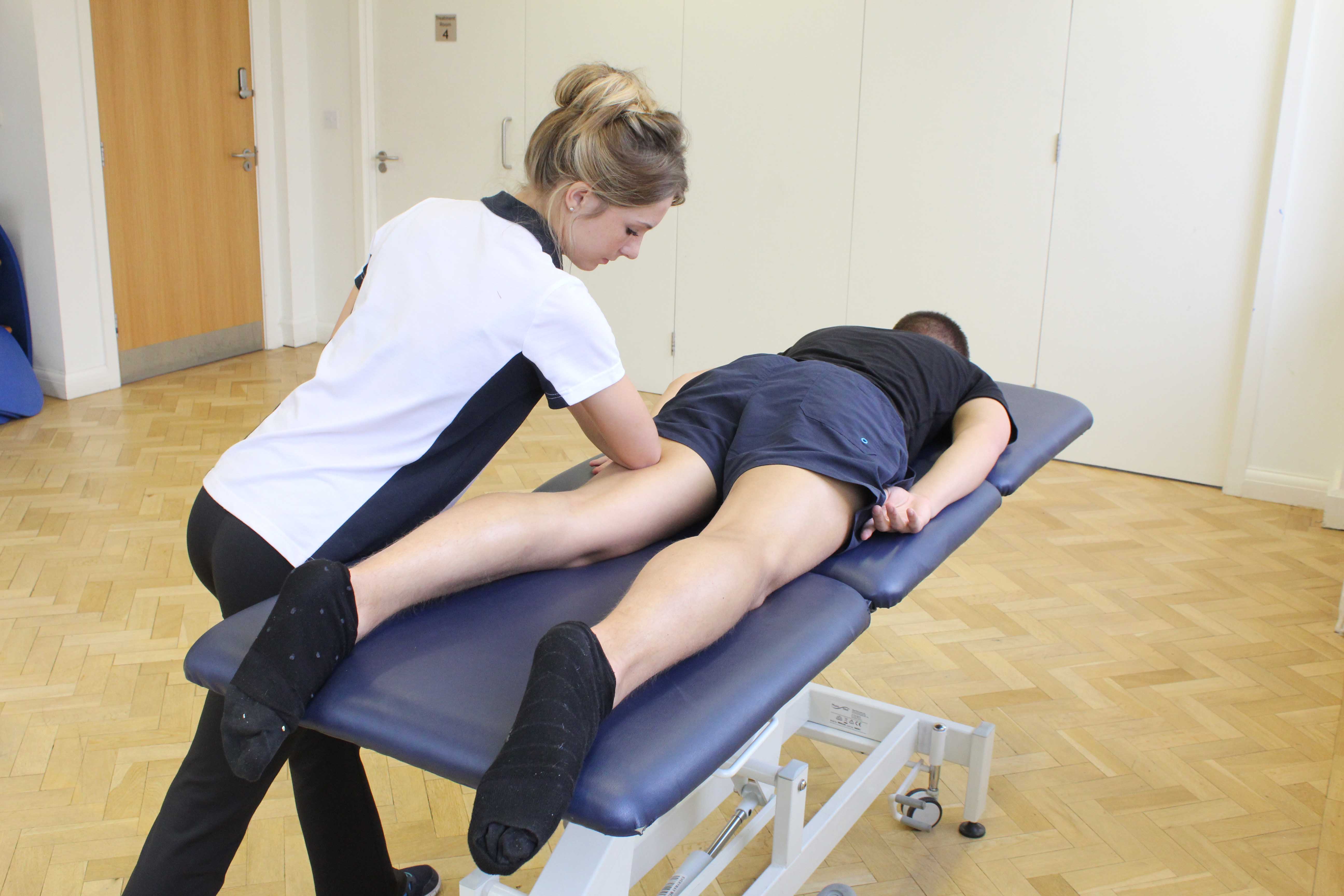 Above: Deep tissue massage of bicep femoris muscle
Above: Deep tissue massage of bicep femoris muscleA thigh massage is an effective treatment used post event. Intense exercise can cause muscle tightness and tension. A thigh massage helps loosen the muscles that have become tight. When muscles become damaged from exercise, scar tissue is formed to help repair damage. Scar tissue is restrictive and causes muscles to become tight. A thigh massage increases the temperature of muscles, which helps loosen scar tissue. Loosening scar tissue allows fibres to be realigned and increase range of movement therefore reducing pain.
A thigh massage can help pre event. A thigh massage helps stimulate the muscles so they are prepared for activity. Before exercise muscles may be tight and have a shorter range of movement. A thigh massage helps increase the temperature of the muscles so that they relax and increase in flexibility and range of movement. Improving range of movement also reduces the risk of injury during the event. If range of movement is short, there is an increased risk of pulling, straining or tearing muscles as movement is restricted. An increase of range of movement allows the muscles to stretch more during short bursts of movement.
A thigh massage can help post injury. Common injuries in the thigh include; strain, pulls and tears. A thigh massage will help relieve pain, tension, stress and tightness. A thigh massage can help enable muscles to relax. A thigh massage also stimulates the lymphatic system. The lymphatic system is a series of lymph vessels that aids in the removal of waste products back into the blood so that it can be removed from the body. The lymphatic system also helps fight infection. The removal of waste products enables the muscles to be relieved of muscle tension, tightness and pain caused as a result of injury. Fighting infections also prevents the muscles from further damage.
Acute pain can be helped by a thigh massage. Pains such as aching in the muscles and fatigue are relieved. Pain is created as nerves in the body receive a signal from the brain to cause pain. The brain receives the message to send a signal from receptors located in the body. Receptors sense when damage has occurred. A thigh massage helps reduce pain by interrupting the signal sent from the brain to the nerves. Interrupting the signal stops the nerves from causing pain. A thigh massage also helps reduce pain and muscle tightness within the thighs by increasing the temperature of the muscle. Increasing the temperature of the muscle helps improve muscle elasticity and flexibility. An increase in blood flow is also encouraged around the body. An increase in blood flow supplies the muscles with oxygen and healthy nutrients to help the muscles become stronger and healthier.
Muscle tightness is commonly treated using a thigh massage. Using a range of different techniques, a thigh massage increases the temperature and loosens muscles. Increasing the temperature of the muscles helps them relax and relieve pain as muscle elasticity is improved. Tight muscles can occur for many reasons such as overuse and injury. A thigh massage helps reduce pain within the muscles caused by tightness. A thigh massage can help reduce muscle spasms and pain.
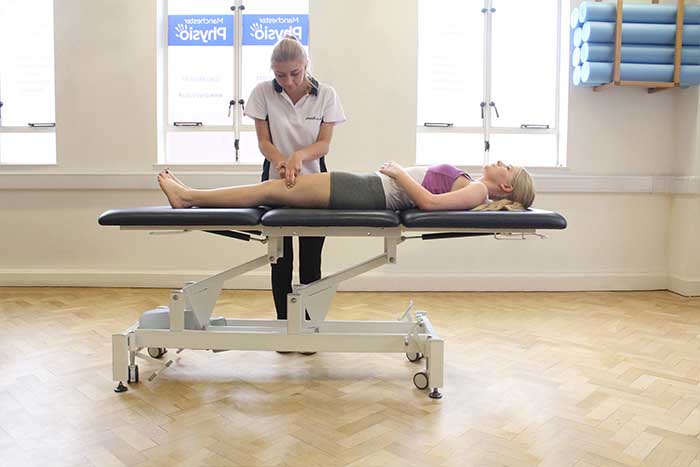
What are the benefits of a thigh massage?
There is a wide range of different benefits that can be gained following a thigh massage. Benefits gained from a thigh massage include:
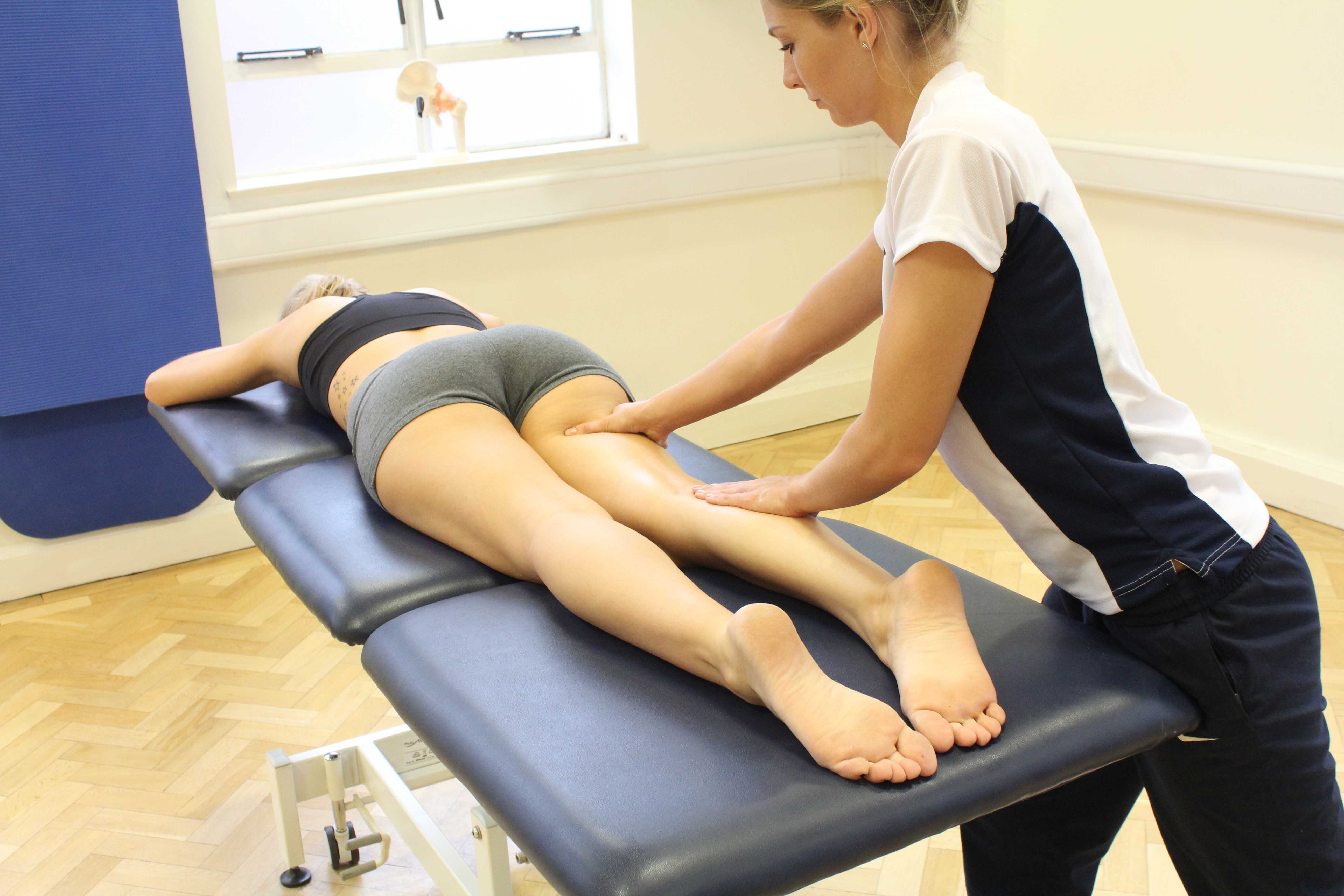 Above: soft tissue massage of bicep femoris and semitendinosus muscles
Above: soft tissue massage of bicep femoris and semitendinosus musclesA thigh massage helps by improving recovery. A thigh massage improves the blood circulation, which provides the muscles with more healthy nutrients and oxygen. A thigh massage also improves the lymphatic circulation. Improving the lymphatic circulation aids in the removal of waste products and toxins within the muscles. Oxygen and nutrients supplied to the muscles by a thigh massage help the body's natural healing process to speed up. The body's natural healing process fights off any harmful bacteria and stops any further internal bleeding of the muscles. A protective layer surrounds the injured muscle and prevents the injury from becoming any worse. An increase in nutrients, a decrease of toxins and a protective layer around the muscle therefore speeds up the recovery. Decreased pain is a common benefit gained by a thigh massage. Pain in the muscles can occur for many reasons due to muscle tension and tightness. Muscle tension and tightness can also be caused by various reasons such as overuse, injury and after strenuous activity. A thigh massage uses a range of different techniques to help release any muscle tension, relieve any stress and loosen any tight muscles. An increase in temperature of the muscles, improves muscle elasticity and flexibility resulting in reduced muscle tightness and tension. A reduction in muscle tightness and tension therefore lessens pain within the muscles.
A thigh massage can help improve circulation. The blood circulation is improved as the muscles increase in temperature. An increase in capillarisation and vasodilation then occurs. An increase in capillarisation increases the amount of oxygen that can be delivered around the body. Vasodilation is the widening of blood vessels to allow more blood flow. The lymphatic circulation is also stimulated which helps the body remove any waste products and toxins more. Increased healing is also encouraged around the body and better health is promoted as blood and lymph circulation is improved.
Prevention of injury is a common benefit achieved through a thigh massage. An improvement in blood circulation encourages healthy nutrients and oxygen to be supplied around the body. An improved lymph flow aids in the removal of waste products in the muscle tissues, back into the blood to be removed from the body. The lymphatic system also helps fight infection. Improving both the blood and lymphatic circulation helps the muscles in the thigh become stronger and healthier and therefore less likely to become injured.
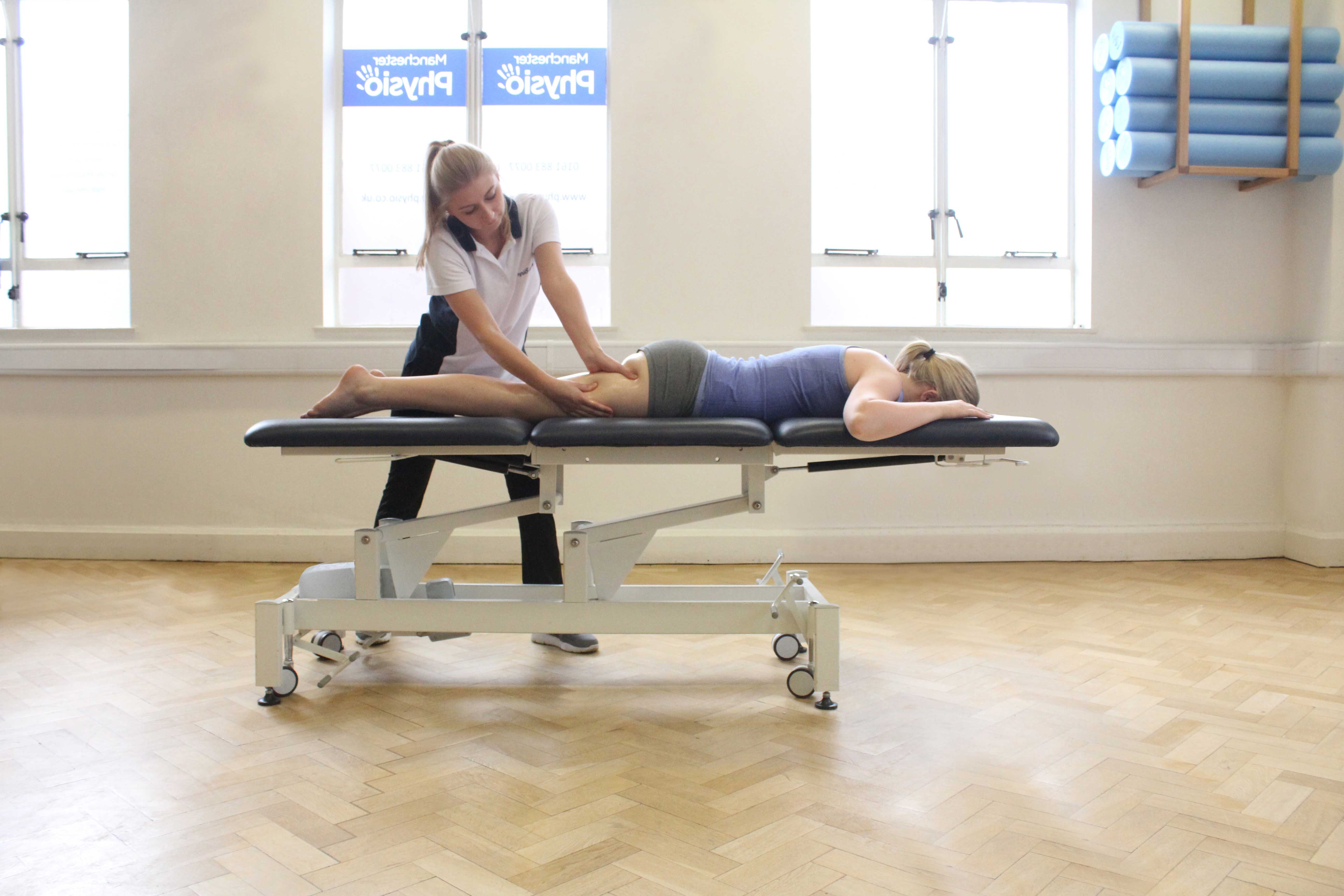 Above: Deep tissue massage of vastus lateralis
Above: Deep tissue massage of vastus lateralisSummary
A thigh massage is used on the hamstring and quadriceps muscles located in front and back of the thigh. A variety of techniques are used during a thigh massage including effleurage, kneading, frictions and wringing. A thigh massage is used to help post event, pre event, post injury, acute pain and muscle tightness. Benefits of a thigh massage include improved recovery, a decrease in pain, improved circulation of both blood and the lymph flow and prevention of further injury. Our massage therapists at physio.co.uk use thigh massage to help treat muscle pain, muscle tightness, stress and muscle tension.
How can I arrange a thigh massage?
The easiest way to arrange a thigh massage at Physio.co.uk is to email us at office@physio.co.uk or call us on 0800 033 7800.
Alternatively if you have any questions please feel free to contact us.
We offer a 7 day service and provide home and clinic appointments.
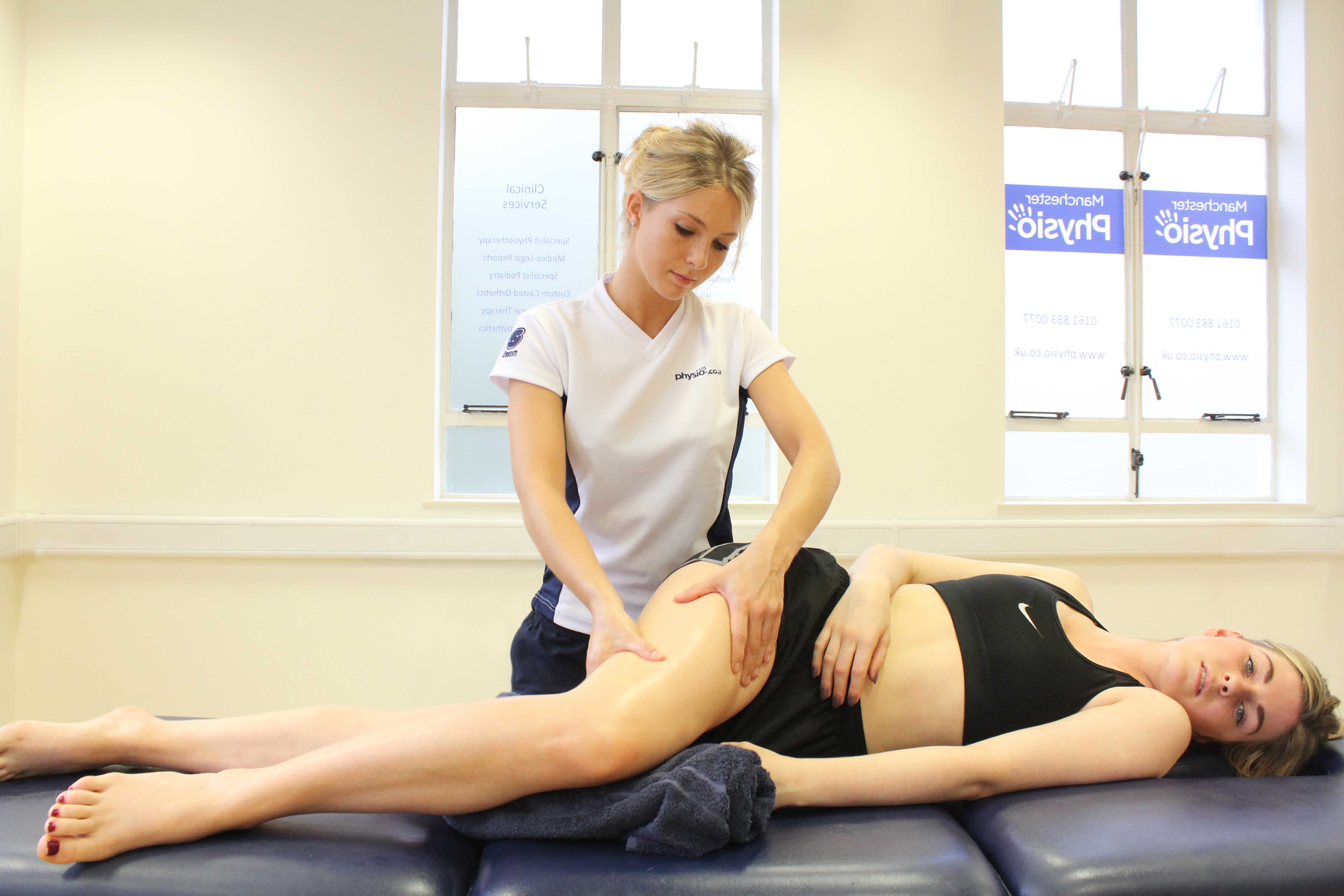 Above: Soft tissue massage of the vastus lataralis
Above: Soft tissue massage of the vastus lataralis
 0330 088 7800
0330 088 7800






































